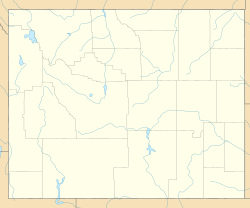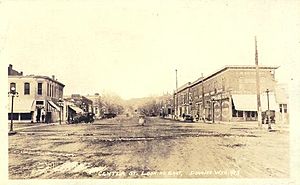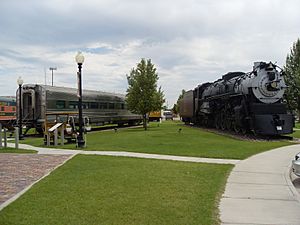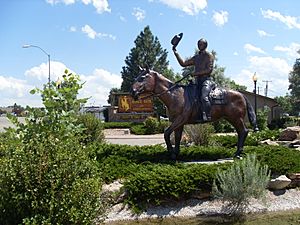Douglas, Wyoming facts for kids
Quick facts for kids
Douglas, Wyoming
|
|
|---|---|
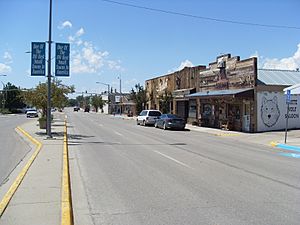
Center Street (city center), view to the west
|
|
| Motto(s):
"Home of the Jackalope"
|
|
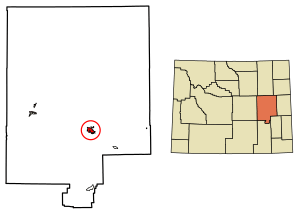
Location of Douglas in Converse County, Wyoming.
|
|
| Country | |
| State | |
| County | Converse |
| Area | |
| • Total | 6.66 sq mi (17.25 km2) |
| • Land | 6.50 sq mi (16.84 km2) |
| • Water | 0.16 sq mi (0.41 km2) |
| Elevation | 4,836 ft (1,474 m) |
| Population
(2020)
|
|
| • Total | 6,386 |
| • Estimate
(2023)
|
6,449 |
| • Density | 978.63/sq mi (377.87/km2) |
| Time zone | UTC−7 (Mountain (MST)) |
| • Summer (DST) | UTC−6 (MDT) |
| ZIP code |
82633
|
| Area code(s) | 307 |
| FIPS code | 56-21125 |
| GNIS feature ID | 1587750 |
| Website | City of Douglas Wyoming |
Douglas is a city in Wyoming, United States. It is the main city of Converse County, Wyoming. In 2020, about 6,386 people lived there. Douglas is famous for hosting the Wyoming State Fair every year.
Contents
History of Douglas
Douglas started as a settlement in 1867 when Fort Fetterman was built. It was first called "Tent City." In 1886, a railway station was built, and the town was officially named "Douglas." It was named after Senator Stephen A. Douglas.
The city became an important place for supplying nearby cattle ranches. It also served railway workers, cowboys, and soldiers from Fort Fetterman. During World War II, Douglas was home to a prisoner of war camp. The old train station is now a historic landmark.
Geography and Climate
Douglas covers about 6.66 square miles (17.25 square kilometers). Most of this area is land, with a small part being water.
Douglas has a semi-arid climate. This means it gets some rain, but it's generally dry.
People of Douglas (Demographics)
| Historical population | |||
|---|---|---|---|
| Census | Pop. | %± | |
| 2010 | 6,120 | — | |
| 2020 | 6,386 | 4.3% | |
| 2023 (est.) | 6,449 | 5.4% | |
In 2020, Douglas had 6,386 people and 2,673 households. Most people (about 95.5%) were White. About 14.7% of the population was of Hispanic or Latino background.
Many people in Douglas have German, Irish, or English family roots.
About 26.4% of the people were under 18 years old. About 15.4% were over 65. The city had slightly more males (51.9%) than females (48.1%).
The average income for a household in Douglas was about $71,155.
Culture and Fun in Douglas
Douglas is located by the North Platte River. It grew a lot after the Fremont, Elkhorn and Missouri Valley Railroad made it a stop. The railroads brought many settlers to the West. Douglas is also close to beautiful natural areas like Medicine Bow National Forest and Ayres Natural Bridge.
The old train station is now the Douglas Railroad Interpretive Center. It has a free outdoor exhibit with eight real railroad vehicles, including a steam train!
Wyoming State Fair
Every August, Douglas hosts the big Wyoming State Fair. It's a huge event with a fun carnival, live shows, and exciting rodeo competitions. Many famous country music stars have performed there. In 2012, the fair had 60,000 visitors, which is a lot for Wyoming!
The fair also works closely with the 4-H Club, a group for young people interested in farming and community.
Horse Culture
Douglas has a long history with horses, going back to the days of Fort Fetterman. The first horse to win the American Triple Crown, a famous racehorse named Sir Barton, is buried here. The Wyoming State Fair is well-known for its rodeo and animal shows. You can also visit the Wyoming Pioneer Memorial Museum on the fairgrounds. It has old items from pioneers and Native Americans who lived in Converse County.
Jackalopes
Douglas is known as the "Home of the Jackalope"! The jackalope is a mythical creature that looks like a jackrabbit with deer antlers. The legend started in 1932 with Douglas Herrick, who lived in Douglas.
The city even gives out special "Jackalope Hunting licenses" to tourists. But don't get too excited – these licenses are only good for one day, June 31st, which doesn't exist!
The story goes that Douglas Herrick and his brother were taxidermists (people who prepare animal skins). One day, Herrick put a jackrabbit next to some deer antlers, and the idea for the jackalope was born!
Education in Douglas
Kids in Douglas go to schools run by Converse County School District Number 1. There are schools for all ages:
- Douglas Primary School (Kindergarten-1st grade)
- Douglas Intermediate School (2nd-3rd grades)
- Douglas Upper Elementary School (4th-5th grades)
- Douglas Middle School (6th-8th grades)
- Douglas High School (9th-12th grades)
Douglas also has a branch campus of Eastern Wyoming College, where students can take college classes. There is also a public library in Douglas.
Getting Around Douglas
Highways
Several highways pass through Douglas, making it easy to travel to and from the city:
 I-25 This major highway runs north and south.
I-25 This major highway runs north and south. I-25 Bus. This is a business route of I-25 that goes through the center of Douglas.
I-25 Bus. This is a business route of I-25 that goes through the center of Douglas. WYO 59
WYO 59 WYO 91
WYO 91 WYO 93
WYO 93 WYO 94
WYO 94 WYO 96
WYO 96
Transit
You can catch a bus in Douglas through a service called Express Arrow.
Airport
The closest airport with passenger flights is Casper/Natrona County International Airport. It's about 58 miles west of Douglas. You can fly there with airlines like United Express, Delta Connection, and Allegiant Airlines.
Radio Stations
Douglas has a few local radio stations:
- KKTY (AM) 1470 and 93.3FM: Plays classic hits and broadcasts sports games like the Wyoming Cowboys and Denver Broncos.
- KKTY-FM 100.1: Plays country music.
- KKTS-FM 99.3: Plays hot adult contemporary music.
Famous People from Douglas
- David R. Edwards (1938-2013) — A politician who was part of the Wyoming House of Representatives.
- Michael John Sullivan (born 1939) — He was the Governor of Wyoming from 1987 to 1995.
- George H. Cross (1854-1946) — A state senator for several terms.
See also
 In Spanish: Douglas (Wyoming) para niños
In Spanish: Douglas (Wyoming) para niños


